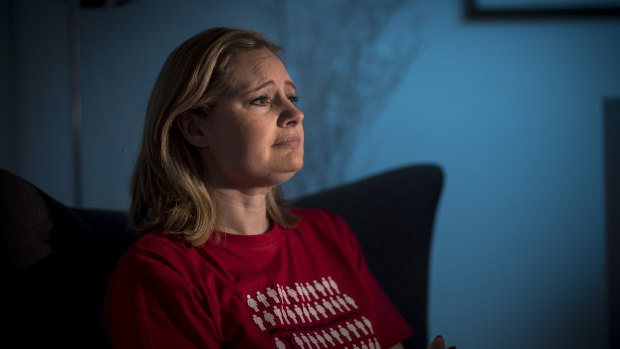By Aisha Dow
At her lowest point, Krista Callinan lay sobbing in the bath and wondered “am I better off dead?”
Before the 38-year-old was struck down by a painful disease with an unknown cause, she was a busy business owner and an experienced ski patrol volunteer.
Now she can’t go to the supermarket without a wheelchair to help preserve her energy, and is often confined to her apartment, watching the world from above.
Everyone else hurries along.

Krista Callinan, 38, lives in constant pain.Credit: Eddie Jim
Krista has myalgic encephalomyelitis, a highly-stigmatised and misunderstood condition also known as chronic fatigue syndrome.
More than 200,000 Australians are thought to suffer from the disease. They have been described as “missing people”, because as their symptoms get progressively worse, they disappear from employment and much of public life.
A recent research by advocacy group Emerge Australia surveyed more than 600 sufferers and found that while 52 per cent had been in full-time work before the onset of the syndrome, it plummeted to just 7 per cent afterwards.
The impact on men was particularly stark. Their income dropped from a mean average of almost $55,000 to $21,000.
Chief executive of Emerge Australia, Dr Heidi Nicholl, said that about a quarter of people with chronic fatigue syndrome were so severely unwell they were confined to their bed or their home.
“They are not out there doing protests,” she said. “Our patients just disappear from public view.”
Chronic fatigue syndrome is a complex disorder that sees people crash out from exhaustion for days, unable to think clearly, following even relatively-minor activities. It can also be accompanied by a host of other unpleasant symptoms, including pain in the muscles and joints, gastrointestinal disorders and an impaired immune system.
Complicating treatment is the fact that doctors still do not know what causes it.
Some have claimed it could be a mental illness, but more-recent research suggests this could be incorrect, and that it is a physical illness which could be caused by problems producing energy at a cellular level.
Controversially, some Australian doctors are still prescribing a type of exercise treatment no longer recommended by the US Centres for Disease Control and Prevention, which warned exercise programs for patients who cannot tolerate basic activities can be counterproductive and even harmful.
President-elect of the the Royal Australian College of General Practitioners, Dr Harry Nespolon, said graded exercise was only one treatment option for chronic fatigue syndrome, and no two cases of the condition were identical.
But Dr Nicholl said the controversy around exercise therapy served to highlight the absence of effective treatments. “And … it really comes from this discredited model that it is a psychosocial disease, where it is all in the mind,” she said.
The Emerge Australia survey found that exercise made people feel worse in almost 90 per cent of cases.
Many people with chronic fatigue syndrome instead use a technique called “pacing”, where they schedule their activities between extended periods of rest in an attempt to avoid crashing out.
At first Krista Callinan tried to push through her illness and retain her successful book-keeping business in Melbourne, in the belief she’d eventually recover. She now worries this over exertion may have worsened her condition in the long term.
The business no longer has staff, and Krista can only manage to work about 10 hours a week. The former primary school teacher can usually work half a day, followed by a full day of rest, but this doesn’t take into account the energy she needs to conserve for basic activities like going shopping and washing her hair.
“If I was an employee I would have been told a long time ago ‘sorry we just can’t keep you on’,” she said.
Krista is constantly in pain, as her body struggles to clear lactic acid, and the impact on her personal life has been monumental. She’s managed only to go on two dates since the onset of her sickness about five years ago.
“I was the most maternal person from the age of 16. I now wonder if I ever will still try to have kids,” she said.
“I’ve got to accept this is my life now.
“[But] I’ve always got hope that we will at least find a treatment to allow me to be a fully-functioning person again.”